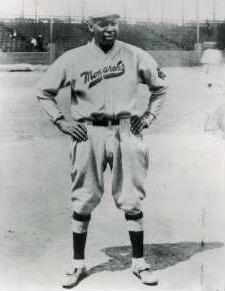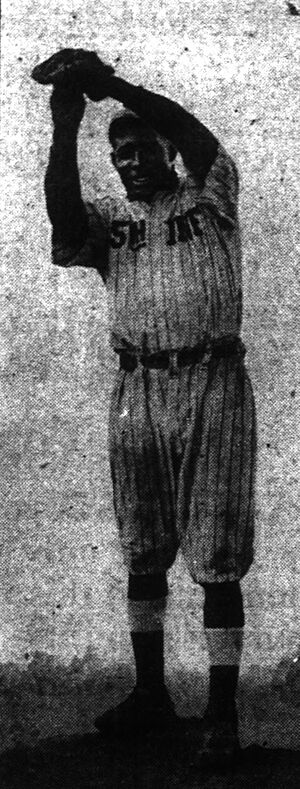Bullet Rogan facts for kids
Quick facts for kids Bullet Rogan |
|||
|---|---|---|---|
 |
|||
| Pitcher and Outfielder | |||
| Born: July 28, 1893 Oklahoma City, Indian Territory |
|||
| Died: March 4, 1967 (aged 73) Kansas City, Missouri |
|||
|
|||
| debut | |||
| 1917, All Nations | |||
| Last appearance | |||
| 1938, Kansas City Monarchs | |||
| Career statistics | |||
| Win–loss record | 120–52 | ||
| Earned run average | 2.65 | ||
| Strikeouts | 918 | ||
| Batting average | .338 | ||
| Hits | 693 | ||
| Stolen bases | 106 | ||
| Teams | |||
As Player
As Manager
|
|||
| Career highlights and awards | |||
|
|||
| Induction | 1998 | ||
| Election Method | Veterans Committee | ||
Wilber Joe Rogan, known as "Bullet Joe" (born July 28, 1893 – died March 4, 1967), was an amazing American pitcher, outfielder, and manager. He played for the Kansas City Monarchs in the Negro baseball leagues from 1920 to 1938. Rogan was famous for being a two-way player. This means he was great at both hitting and pitching. Some records show he won more games than any other pitcher in Negro leagues history. He also had one of the highest batting averages. He was honored in the Baseball Hall of Fame in 1998.
Rogan started his baseball journey in the U.S. Army. He played for a well-known team in the all-black 25th Infantry. After joining the Kansas City Monarchs, he became their top pitcher and one of their best hitters. His team won three championships from 1923 to 1925. They also won the 1924 Colored World Series. In 1926, he became a playing manager. He led his team to another league title in 1929.
Many baseball legends praised Rogan. Satchel Paige said Rogan was the only pitcher he knew who also hit in the cleanup spot (a key batting position). Frank Duncan, his longtime catcher, believed Rogan was even better than Paige because he could hit so well. Casey Stengel called Rogan "one of the best—if not the best—pitcher that ever lived."
Contents
Early Life and Baseball Beginnings
Wilber Rogan was born in Oklahoma City, Oklahoma. His exact birth name is a bit of a mystery. His Hall of Fame plaque says "Wilber Joe Rogan." But other records have called him "Charles Wilber Logan."
In 1908, after his mother passed away, he moved to Kansas City, Kansas. He went to Sumner High School there. He started playing baseball in 1911. He was a catcher for a semi-pro team called Fred Palace's Colts. This team was mostly made up of teenagers.
Rogan left high school early and joined the Army on October 19, 1911. He was unhappy with his segregated school. He also had some problems with his stepmother. He lied about his age to join the Army. This caused confusion about his birth year later on. Most historians now agree he was born in 1893.
Army Baseball Star
Rogan served in the Philippines for three years. He was part of the 24th Infantry Regiment. This was an all-black regiment. He was honorably discharged in 1914.
Before returning to the U.S., Rogan joined the 25th Infantry. This was another African American unit. They were stationed in Hawaii. He was specifically asked to join their famous baseball team, the "Wreckers." He played his first game with them on July 4, 1915.
Many of his Army teammates later became stars in the Negro leagues. These included Dobie Moore and Heavy Johnson. Over the next three seasons, the Wreckers won several championships. In 1917, Rogan even beat the Portland Beavers twice. They were a professional team from the Pacific Coast League. Rogan played professionally for a few months in 1917. He played for the Los Angeles White Sox and J. L. Wilkinson's All Nations Club. But he returned to the Army for three more years.
In 1918, Rogan's unit moved to Arizona. Some researchers say Casey Stengel saw Rogan play there in 1919. Stengel then recommended him to Wilkinson for his new team. This team was the Kansas City Monarchs. However, Rogan had already played for Wilkinson's team earlier.
Becoming a Monarchs Legend
In July 1920, Rogan and Dobie Moore joined the Kansas City Monarchs. Rogan quickly became the best pitcher in the league. He also drew big crowds. By 1922, his third season, he was hitting .390. His 13 home runs were second-best in the league.
On August 6, 1923, Rogan and teammate José Méndez pitched a no-hitter. They played against the Milwaukee Bears. Méndez pitched the first five innings, and Rogan finished the last four. That season, Rogan hit .364. He also led the league with 16 wins and 151 strikeouts. This helped the Monarchs win their first championship.
World Series Champion
In 1924, Rogan hit .395 and had an 18–6 pitching record. He led the Monarchs to their second league title. He was a star in the first Black World Series. He led the Monarchs with 13 hits. He also won two games as Kansas City beat the Eastern Colored League champions, the Hilldales. That winter, he led the Cuban League with nine wins. He played for the champion Almendares team.
Rogan had an amazing year in 1925. He helped Kansas City win their third straight championship. He had a 17–2 pitching record and a .381 batting average. In the playoffs, he hit .450 and won three more games. But before the World Series rematch, Rogan hurt his knee. He had to miss the series. Without him, the Monarchs lost.
Manager and All-Star
The next season, Rogan became the manager of the Kansas City Monarchs. He continued to play. In 1928, at age 34, he was still the Monarchs' best hitter (.358). He was also one of their best pitchers (10–2). That year, he hit three home runs in one game.
Rogan continued to lead the Monarchs in 1929. They won their fourth championship. They also had the best record (62–17) in the league's history. On April 29, 1930, Rogan played in baseball's first night game. This game was in Enid, Oklahoma. He was hospitalized for an illness in August. He returned to play in September 1931.
In 1932, Rogan joined a white independent team in North Dakota. He played there until August. He batted .315 and had a 20–3 pitching record. He then returned to the Monarchs. In the winter of 1933 and 1934, Rogan toured Hawaii and the Philippines. He was part of the Philadelphia Royal Giants, an all-star team. They also toured Japan and China. In 1936, at 43, Rogan played in the East-West All-Star Game.
Rogan's Amazing Skills
Rogan was not very tall (5 feet 7 inches, 160 pounds). But he was strong and well-built. He threw and batted right-handed. He used a very heavy bat. Buck O'Neil said Rogan could hit the ball like Ernie Banks. Frank Duncan said Rogan was great at hitting low balls and curveballs. He even taught other players how to hit curveballs. Rogan was not super fast, but he ran the bases well. He would steal bases when needed.
A Powerful Hitter and Pitcher
As a pitcher, Rogan used a unique delivery. He threw both overhand and sidearm. He had many different pitches. These included curveballs, a spitball, a palmball, a forkball, and a very fast fastball. This fastball gave him his nickname, "Bullet."
Frank Duncan, who caught for both Rogan and Satchel Paige, said Rogan was harder to catch. Paige could throw the ball exactly where he wanted it. But Rogan's pitches were "all over the plate." He might walk more batters, but he didn't give up many runs. Duncan said Rogan's fastball had more "steam" than Paige's. His curveball was also better. Batters thought it was a fastball, then it would sharply break for a strike.
Another teammate, George Carr, called Rogan the greatest pitcher ever. He said Rogan was smart and had a great memory. Once Rogan pitched to a batter, he remembered their strengths and weaknesses. Carr also said Rogan's fastball was "almost too fast to catch."
Leading the Team
As a manager, Rogan was very strict. This might have been because of his military background. Some players felt he gave too many orders. They sometimes resented it. Another pitcher, Chet Brewer, said Rogan wasn't the best teacher. He would just tell pitchers to throw the ball like he did.
At first, Rogan didn't trust younger players much. He often played himself instead of them. But over time, he changed. He became known for teaching and helping less experienced players grow.
Life After Baseball
On October 22, 1922, Wilber Rogan married Kathrine McWilliams. Their son, Wilber Rogan, Jr., was born in 1924. After he stopped playing, Rogan became an umpire in the Negro American League. He worked there until 1946. After that, he worked at the post office.
Bullet Joe Rogan passed away in Kansas City, Missouri, on March 4, 1967. He was 73 years old. The Baseball Hall of Fame started including Negro league players in the 1970s. But Rogan was not honored until 1998. This was 31 years after he died.
Career Highlights
Rogan's lifetime totals against all types of teams, including semi-pro and Army teams, were impressive. He won more than 350 games as a pitcher. He had over 2000 strikeouts. As a hitter, he got over 2500 hits. He also hit more than 350 home runs and stole over 500 bases.
Negro leagues
- Negro league baseball statistics and player information from Seamheads.com, or Baseball-Reference (Negro leagues)
Images for kids






